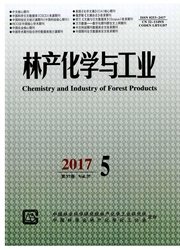

 中文摘要:
中文摘要:
采用热重-红外联用(TG-FTIR)、裂解-气相色谱/质谱联用(Py-GC/MS)技术和小型固定床装置,考察了棕榈壳的热解失重过程和产物特性,并进一步评价了热解半焦的气化反应性。结果表明:棕榈壳热解失重过程大致分为干燥(25-236℃,3.42%)、主失重(236-400℃,52.31%)和炭化(400-850℃,14.90%)3个阶段,1.5级或2级反应可以较好描述棕榈壳热解反应的主失重过程;升温速率10-30 K/min下,反应表观活化能为67.63-76.47 k J/mol;热解过程主要气体产物的释放量顺序分别为CO2、H2O、CH4和CO;600-850℃下,棕榈壳主要热解产物为液相产物,其质量产率36.8%-50.9%,能量产率41.3%-58.9%,主要组分包括苯酚、乙酸、十八烷酸、十六烷酸、4-烯丙基-2,6-二甲氧基苯酚等物质,其中苯酚GC含量较高(12.56%-15.49%),这可能主要与原料木质素的含量较高有关;固相产物的质量和能量产率分别为20.6%-26.7%和27.4%-35.0%,其CO2气化反应性相对低于稻秆、木粉等常见生物质。
 英文摘要:
英文摘要:
The pyrolysis characteristics, mechanism, and products properties of palm kernel shell (PKS) in a bench-scaled fixed bed reactor were investigated by using thermogravimetry-Fourier transform infrared spectroscopy (TG-FTIR), pyrolysis-gas chromatography and mass spectrometry (Py-GC/MS). TG results showed that the pyrolysis of PKS could be devided into three steps, which included drying(25 -236 ℃, 3.42% ), main weight loss(236 -400℃, 52.31% ), and carbonization (400 - 850 ℃, 14.90% ) stage. The main mass loss stage of PKS pyrolysis was controlled by 1.5 or 2 order reaction model, and the apparent activation energies at heating rates of 10 - 30 K/min were 67.63 - 76.47 kJ/mol. The gaseous products were evolved with the sequence of CO2, H2O, CH4, and CO. The quantitative results showed that liquid was the primary pyrolysis product at 600 -850 ℃, with the mass yield of 36.8% -50.9% and energy yield of 41.3% -58.9% according to original material. PyGC/MS results indicated that the main components of liquid products were phenol, acetic acid, octadecanoic acid, nhexadecanoic acid, 4-allyl-2,6-dimethoxyphenol, etc.. It was notable that phneols had a higher relative content, accounting for about 12.56% - 15.49%. Biochar was an important by-product of PKS pyrolysis, with the mass and energy yield of 20.6% - 26.7% and 27.4% - 35.0%, respectively. The CO2 gasification reactivity of PKS char was lower than that of rice straw char and wood char.
 同期刊论文项目
同期刊论文项目
 同项目期刊论文
同项目期刊论文
 期刊信息
期刊信息
